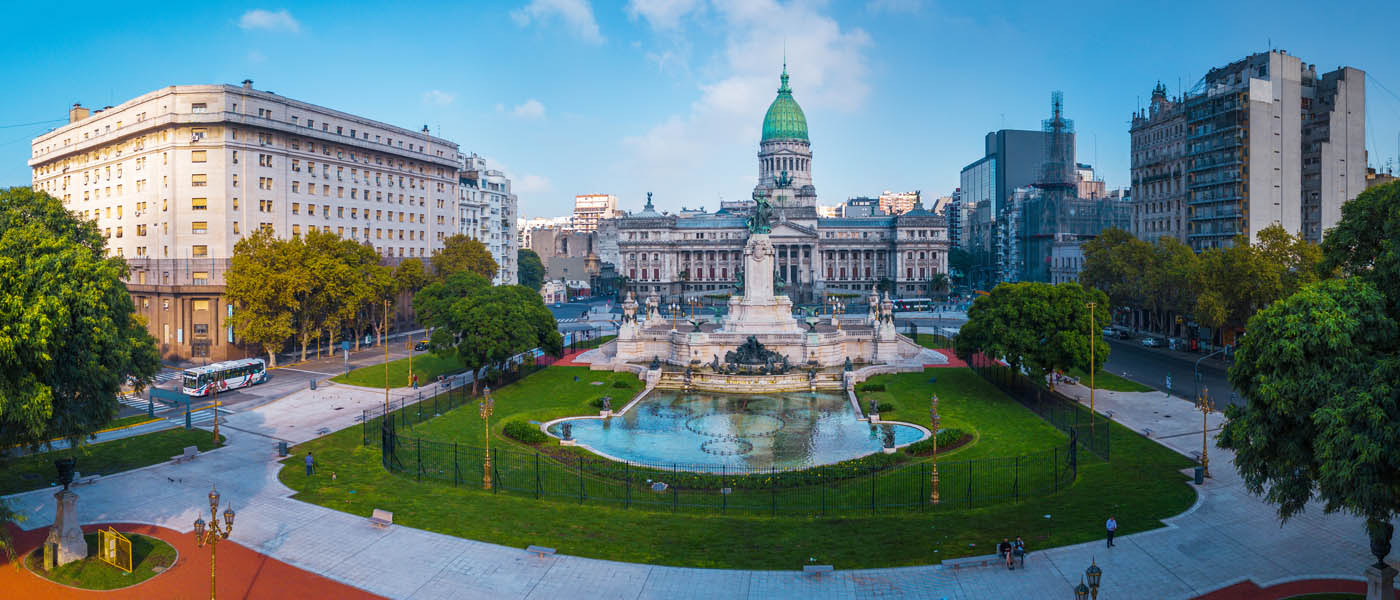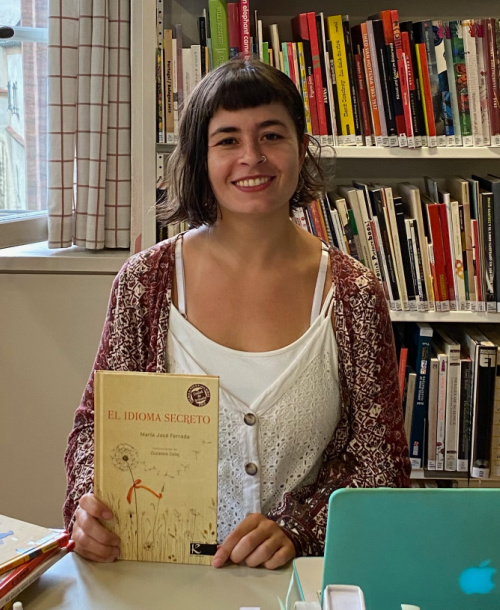
My Secret City: Buenos Aires
Argentina’s capital city combines colonial architecture with Latin passion, hearty food and lively nightlife. Alumna Agustina Palenque (IntM 2022) introduces us to her home city.
Buenos Aires is a city that never sleeps. There are many places to go for a drink to start the night. I usually end up in the neighbourhoods of Chacarita or Almagro (the main street is Guardia Vieja). If you are still awake around 2/3 am, I would recommend you try dancing some cumbia, trap and reggaeton at an Argentinian party, like at C Art Media in Chacarita. If you want to see a genuine tango show, there is a nice spot called Boliche de Roberto, in Almagro. This cosy bar is more than 100 years old and offers authentic tango shows every night. People are very friendly and there is a sort of ‘belonging’ vibe here that makes me feel welcome.
"Buenos Aires is for the passionate!"
You won’t really get to know Buenos Aires until you walk along Avenida Corrientes. No matter what crisis we are living in, this is always a good plan for us locals. Walking underneath the lights of the avenue, facing the iconic Obelisco in the city centre, you will see an important part of the city’s charm. It is usually very crowded because there are three things people from Buenos Aires – known as porteños – love and Avenida Corrientes offers: theatre, books and pizza. I love to walk along the street, going into one of the three or four second-hand bookshops you can find on every block to look for some interesting reads. Afterwards, I enjoy seeing a play at one of the theatres in the area. The plan usually ends with a pizza at any of the traditional pizzerias located around the avenue.
The Centro Cultural Kirchner aims to make culture accessible to all. Located in the city centre, this is an architectural gem that showcases the rich cultural heritage of Argentina. Housed in a historic building, formerly the Central Post Office, this cultural centre has become a vibrant hub for art, music, theatre and dance. It is a space that hosts various artistic expressions such as exhibitions, concerts, plays and dance performances, and entry is free to all. With its stunning auditoriums, art galleries and state-of-the-art facilities, the Centro Cultural Kirchner has become a symbol of cultural enrichment and expression.
After walking along the main streets of the city, when I’m tired and in need of some quiet, my favourite place to recharge my energy is Agronomía. This park is part of the Agronomy School of the University of Buenos Aires. It is said to be one of the city’s 'green lungs'. As well as seeing the animals here, if I visit this spot on the third weekend of the month, there is sometimes a big market with organic food and other eco-friendly products. After buying some vegan and organic fairtrade products, I go for a walk around this beautiful neighbourhood and even get to see the former house of the famous novelist Julio Cortázar.
My favourite day trip from the city is to Delta del Tigre, a labyrinth of waterways, verdant islands and serene beauty. It’s hard to imagine that such a paradise is just a 45-minute train ride away from this gigantic bustling city. This unique delta offers a tranquil escape from urban life. I love to explore the maze of canals by boat, passing quaint houses, lush vegetation and abundant wildlife along the way. The Delta del Tigre is a hidden gem that draws you in with its serene ambience. If I’m lucky, I may even meet and enjoy the company of some carpinchos/capybaras and many other native species.
I believe that the main event in Buenos Aires that resonates with Argentinian identity and history is the Día de la Memoria por la Verdad y la Justicia (Day of Remembrance for Truth and Justice). Taking place on 24 March each year, it commemorates the military coup that started on that date in 1976, leading to a period of dictatorship characterised by human rights abuses, forced disappearances and political repression. Being part of these types of events reminds me of the strength and unity of a people who knew how to say 'enough' to a dictatorship. This day is a national holiday and serves as a reminder to honour the victims of this dark period in Argentine history and to advocate for truth, justice and human rights. Through banners, art and other political expressions, thousands of Argentinians gather to defend democracy and remember a period of our history that we do not want to repeat: 'Never again'.
ABOUT AGUSTINA

[Photo top: Sadie Teper, Unsplash; photo above: courtesy of Agustina]
Agustina Palenque has called Buenos Aires home for 28 years. Having lived in other countries during that time, she appreciates even more what Buenos Aires has to offer. She is currently working on a bilingual (Wichí-Spanish) literacy project for teenagers, as well as organising creative writing workshops and book clubs for children through a project called Libros para Gigantes (Books for Giants). Agustina also teaches Spanish online to foreign students and writes content about children’s literature for Fundación La Fuente, Chile.
Follow on Instagram
agustina.palenque
librosparagigantes
My food & drink hit list
It’s Saturday morning and you need coffee
You didn’t know this until now, but you also need a ‘medialuna’ – a cross between a brioche and a croissant. Please don’t go to Starbucks. Even though over the last few years the speciality coffee market has grown, and I love it, I would recommend a traditional cafe. Buenos Aires has thousands of cafes where porteños read the newspaper, meet friends and talk passionately about politics, everyday philosophy, the latest football game or just sit alone with a book. The cafe La Poesía (which means ‘The poetry’) in San Telmo is a great option. This cafe has a rich history and captivating character, serving as a literary sanctuary where poets and intellectuals have gathered for decades to share their reflections and music over steaming cups of coffee.
"In Argentina, food is not just to nurture our bodies, we eat to nurture our souls and hearts, to connect with others and to remember we are alive."
It’s summer in Buenos Aires
You’re feeling hot and sticky and the aircon is not enough. Maybe you had a long day and are in the mood for something sweet. Argentinian ice cream (helado) is what I missed the most in terms of sweet stuff while living abroad. One of my favourite brands is the Patagonian brand Rapanuí. They have different ice cream shops around the city placed in beautiful old-style buildings. You can choose any fruity or creamy flavour you like and any dulce de leche variety - this is a must and you won’t regret it.
It’s Friday evening and you’re hungry
To experience pizza in Buenos Aires as the locals do, Imperio in Chacarita is your spot. At the door, I like to say hello to a suspiciously alive-looking statue of Carlitos Balá, a beloved celebrity who is remembered especially for his haircut. I usually order two slices of pizza, one ‘napolitana’ and one ‘fugazetta’ as, given the thickness of this pizza and the generous amount of beautiful cheese, two slices is more than enough. After a few minutes, the pizza maker will yell something like “¿napo y fugazetta?” so you need to pay attention. Take your plate to the big bar where everyone is standing and eating their slices before they take the train or bus to go to work or back home.
"The gastronomic offerings in Buenos Aires have exponentially grown in the last few years."
It’s Sunday afternoon and time for ‘mate’
My favourite place for a mate (a sort of herbal tea served with a metal straw) is … everywhere. It’s made using leaves and twigs from the yerba mate plant and is ubiquitous in Argentina. We drink mate any time and anywhere: at home, at work, at the cinema, walking on the street, at the supermarket, and even at the hospital. If it's a sunny afternoon, the best place to enjoy this wonderful drink is in a park. My favourite is Parque Centenario, in the centre of the city. Don’t forget to buy some pastries at a bakery before you go. You will find different options to accompany your mate: a ‘cañoncito’, meaning little cannon, filled with dulce de leche; a ‘vigilante’, which is slang for policeman and is a buttery pastry; a ‘bola de fraile’, meaning friar's ball, which is a doughnut filled with dulce de leche; or a ‘suspiro de monja’, meaning a nun's sigh, which is sweet fried puff pastry. We thank anarchist immigrants who arrived in Argentina in the last century for the creative and ironic names for pastries!
A traditional meal any day or time
The places to go for an Argentinian meal are bodegónes – traditional eateries offering generous dishes. I’ve recently rediscovered Barcelona Asturias in Palermo. Despite the Spanish name, inside this old restaurant you will only find pictures of Argentinian iconic symbols like our beloved drink Fernet-Branca, the famous tango singer Carlos Gardel and the shield of the local football team Atlanta. The vibe at this restaurant is always fun and the waiters are very friendly. You can come here for just a coffee or a large meal. If you visit on a Sunday evening, you will see many customers enjoying watching a football game. Any dish you order will be affordable, abundant and delicious. I would recommend you try a traditional ‘milanesa a la napolitana con papas fritas’ – breaded steak with tomato sauce and melted cheese, served with French fries.
This article was first published June 2023. All opinions expressed are the views of the author and are not endorsed by the University of Glasgow.
TOP 10 BUENOS AIRES ATTRACTIONS
- Teatro Colon (theatre)
- Puerto Madero (old port area)
- Recoleta (neighbourhood)
- Cementerio de la Recoleta (cemetery)
- Jardin Japones (gardens)
- Museo Nacional de Bellas Artes (museum)
- Bosques de Palermo (park)
- Calle Defensa (neighbourhood)
- Museo de Arte Latinoamericano de Buenos Aires (museum)
- Palermo (neighbourhood)
From Tripadvisor, June 2023


![Colourful buildings and balcony railings in La Boca, Buenos Aires [Photo: Barbara Zandoval, Unsplash]](/media/Media_970566_smxx.jpg)
![Monument at United Nations Plaza resembling a large flower made of metal [Photo: Shutterstock]](/media/Media_970602_smxx.jpg)
![Inside the Theatro Colon (Colon Theater), one of the world's best opera houses - showing the stage, seating and painting on the domed roof [Photo: Shutterstock]](/media/Media_970631_smxx.jpg)
![Aerial view of downtown Buenos Aires [Photo: Shutterstock]](/media/Media_970570_smxx.jpg)
![Casa Rosada (Pink House), presidential Palace in Buenos Aires, view from the front entrance [Photo: Shutterstock]](/media/Media_970603_smxx.jpg)
![Two tango dancers performing at Plaza Serrano in San Telmo neighbourhood [Photo: Shutterstock]](/media/Media_970604_smxx.jpg)
![Obelisk in the middle of a busy street at twilight [Photo: Shutterstock]](/media/Media_970567_smxx.jpg)
![The outside of Parisian-style buildings in the Recoleta neighbourhood [Photo: Shutterstock]](/media/Media_974887_smxx.jpg)
